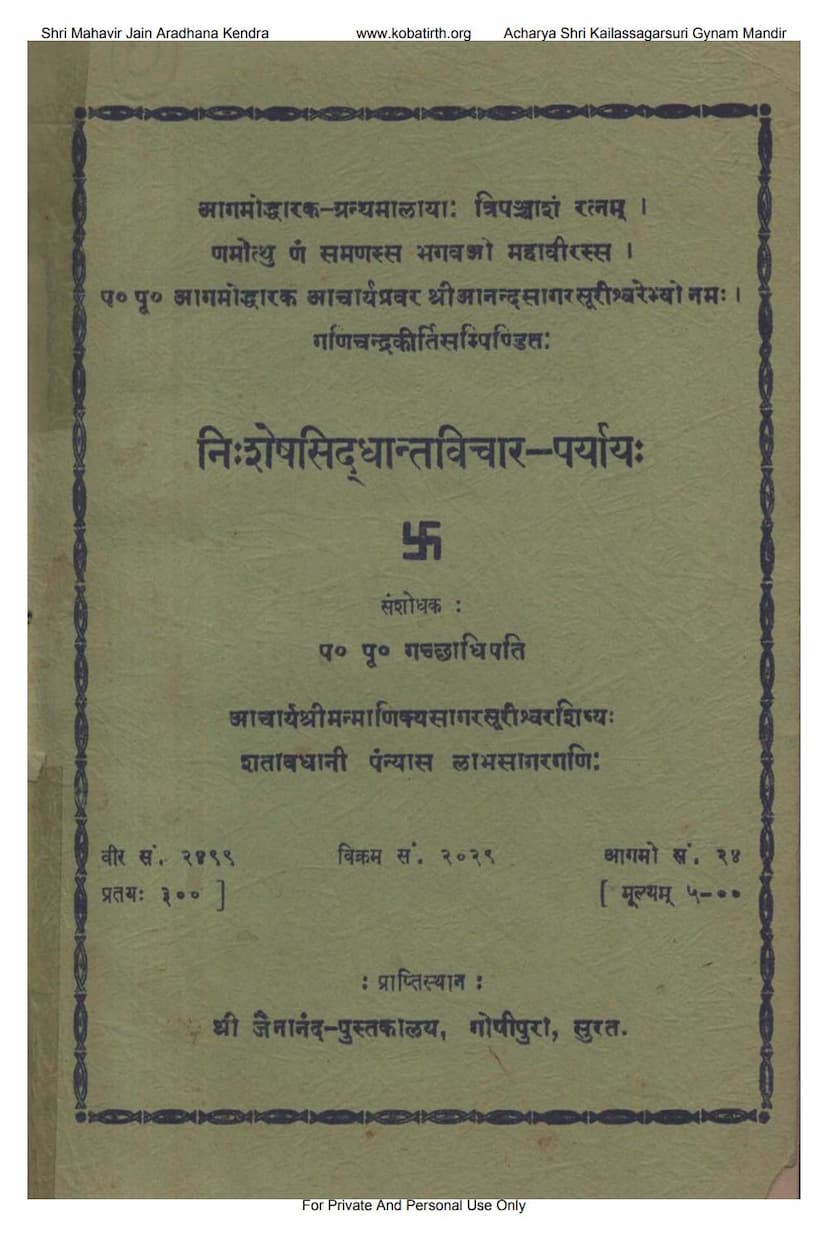Nishesh Siddhant Vichar Paryay
Added to library: September 2, 2025

Summary
Here's a comprehensive summary of the Jain text "Nishesh Siddhant Vichar Paryay" by Labhsagar Gani, based on the provided catalog link and scanned pages:
Book Title: Nishesh Siddhant Vichar Paryay (निःशेषसिद्धान्तविचार-पर्याय) Author: Labhsagar Gani (पंन्यास लाभसागरगणि) Compiled by: Gani Chandrakirti (गणिचन्द्रकीर्ति) Publisher: Jainanand Pustakalay (श्री जैनानंद-पुस्तकालय, गोपीपुरा, सुरत) Series: Agamoddhar Granthamala (मागमोद्धारक-ग्रन्थमाला), 53rd Jewel (त्रिपञ्चाशं रत्नम्) Vikram Samvat: 2029 Vir Samvat: 2199
Overview:
"Nishesh Siddhant Vichar Paryay" is a significant Jain text that delves deeply into various aspects of Jain philosophy and practice, as compiled by Gani Chandrakirti and authored by Labhsagar Gani. The title itself signifies a comprehensive exploration of all Jain principles and doctrines. The book is presented as the 53rd jewel in the "Agamoddhar Granthamala" series, indicating its importance in preserving and disseminating Jain scriptural knowledge.
Key Themes and Content:
The book is structured into two main parts:
- First Section (प्रथमखण्ड): This section contains a detailed analysis and compilation of various principles and philosophical points derived from deep contemplation and churning of the Agamas. These conclusions are presented in Sanskrit. The section covers a wide range of topics, often focusing on the intricacies of the Chedasutras (छेदसूत्र) and their underlying philosophy.
- Second Section (द्वितीय खण्ड): This section is presented as an appendix (परिशिष्ट) and contains the remaining parts of the compilation.
Core Philosophical and Practical Discussions:
The text explores a vast array of subjects, drawing from various Agamas and commentaries. Some of the prominent themes discussed include:
- Agamas as the Foundation of Jainism: The introduction emphasizes the Agamas as the bedrock of the Jain tradition, established before the establishment of the Sangha. The acquisition of Agamic knowledge is seen as a difficult but rewarding path leading to liberation.
- Historical Context of Agam Preservation: The text touches upon the oral tradition of Agamic knowledge in ancient times and the monumental effort by Acharya Devagani Kshamashraman to compile the Agamas into written form at Valabhi to ensure their preservation and accessibility.
- The Nature of the Chedasutras: The book highlights the significance of the Chedasutras, considering them central to the orderly functioning of the Jain administration and philosophy. The compilation primarily focuses on the discussions and interpretations related to these sutras.
- Detailed Explanations of Jain Practices and Doctrines: The bulk of the content, as indicated by the extensive table of contents and the text of the chapters, delves into minute details of Jain practices and philosophical concepts. This includes:
- Rules for Monks and Lay Disciples: Discussions on the conduct of monks (sadhus) and lay followers (shravakas), including their respective observances, repentance rituals (pratikraman), dietary rules, clothing, and devotional practices (chaityavandan).
- Rituals and Observances: Detailed explanations of various rituals like massakalpa (monthly vow), varshakalpa (monsoon retreat), paryushana (annual fasting period), pratikraman (repentance), chaitravandan (worship of Jinas), pramarjan (cleaning), vrata (vows), prashchitta (penance), and tapas (austerities).
- Epistemology and Ontology: Discussions on the nature of knowledge, reality, and the spiritual path to liberation.
- Classification of Monks and Lay Followers: Distinguishing between different types of ascetics and householders based on their practices and adherence to vows.
- Rules related to specific situations: The text addresses various rules concerning travel, dwellings, interactions with the opposite sex, handling of materials, and the use of sacred texts.
- Deva Dravya (Divine Property): Discussions related to the handling and usage of property dedicated to deities or religious purposes.
- The concept of 'Tirthankara-kalpa': Understanding the conduct and practices of Tirthankaras and how they should be emulated.
- Dharma and Ethics: The importance of righteous conduct, ethical principles, and their practical application in daily life.
- Karma and Liberation: Underlying principles of karma, its effects, and the path to liberation from the cycle of birth and death.
- Interlinking of Agamas: The text frequently references and quotes from various Agamas such as the Acharanga Sutra, Sutrakritanga, Bhagavati Sutra, Shatkhandagama, Nishitha Sutra, Brihatkalpa Sutra, Oopapaataka Sutra, Jnana Dharma Katha, Upasaka Dashaka, and Raya Praseniya. This demonstrates the interconnectedness of Jain scriptural knowledge.
- Interpretation of Difficult Passages: The book aims to clarify and simplify complex and profound meanings found in the Agamas using accessible Sanskrit language.
- Compilation and Commentary Style: The author/compiler extracts verses from the Agamas and then provides concise Sanskrit explanations or conclusions, making the teachings understandable even for those with limited knowledge of the original texts.
Significance and Utility:
- Agamic Glossary: The book is recognized as serving as an "Agamic dictionary" or "Agamic lexicon," providing meanings and explanations for terms found across various Agamas.
- Preservation of Knowledge: By compiling and clarifying these complex principles, the work contributes to the preservation and propagation of Jain knowledge.
- Guidance for Spiritual Practice: It serves as a valuable guide for spiritual aspirants seeking to understand and implement the teachings of Jainism in their lives.
- Scholarly and Devotional Effort: The effort involved in compiling, researching, and presenting such a vast amount of information is highly commendable and reflects a deep commitment to Jain scholarship and devotion.
In essence, "Nishesh Siddhant Vichar Paryay" is a monumental work that meticulously breaks down and explains the vast and intricate philosophical and practical framework of Jainism, drawing extensively from its scriptural heritage. It acts as a bridge between the profound wisdom of the Agamas and the seeker's understanding, offering a comprehensive resource for studying and practicing Jainism.